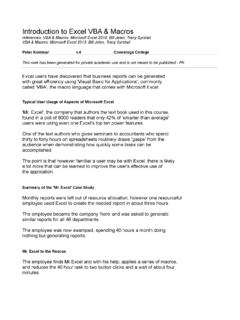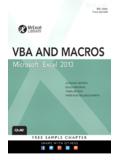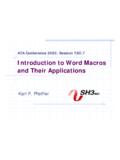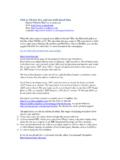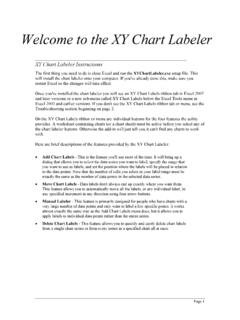Transcription of TECHNOLOGY SKILLS PORTFOLIO - Welcome to NYC.gov
1 TECHNOLOGY SKILLS PORTFOLIOC itywide Learning & Development| 9 | TECHNOLOGY SKILLS PORTFOLIOC itywide Learning & Development offers a full complement of software courses, including Microsoft Office products, Adobe products, IT Certification, eLearning at Your Desktop, and Online Live Office Products ..10 Access ..10 Excel ..15 Outlook ..29 PowerPoint ..33 Project ..36 Publisher ..38 Visio Professional ..39 Word ..41 Microsoft Office 2016: Transition from Office 2007/2010 ..47 Excel Blended Learning ..25 Adobe CC ..48 Crystal Reports ..52eLearning at Your Desktop ..53IT Professional & Certification Courses ..54 TECHNOLOGY SKILLS PORTFOLIOL&D Spring 2018 Course Catalog| 10 |Microsoft Office Products Access 2010 Access 2010, Part 2 Participants will practice advanced Access 2010 features such as database management, form design, packaging a database, encrypting a database, preparing a database for multi-user access and : Restructure data into appropriate tables to ensure data dependency and minimize redundancy Write advanced queries to analyze and summarize data Create macros Customize reports by using various Access features Maintain your database using Access toolsTarget Audience: Database administrators or prospective database administrators who have experience working with Access 2010 and need to learn advanced skillsCourse CodeDays of TrainingDatesCostCEUs/CPEsT40522 Jan 16-17$.
2 Access 2010, Part 1 TECHNOLOGY SKILLS PORTFOLIOC itywide Learning & Development| 11 |Course CodeDays of TrainingDatesCostCEUs/CPEsT40612 Feb 22-23$ : Basic knowledge of computer applications Microsoft Office Products Access 2013 Access 2013, Part 1In this course, participants will learn how to use Access 2013 to manage their data, including creating a new database; constructing tables; designing forms and reports; and building queries to join, filter, and sort : Get to know the layout of Access 2013 Work with table data Query a database Create advanced queries Generate reports Customize the Access environment Design a relational database Join tables Organize a database for efficiency Share data across applications Explore advanced reportingTarget Audience: Employees who wish to establish a foundational understanding of Microsoft Office Access 2013 TECHNOLOGY SKILLS PORTFOLIOL&D Spring 2018 Course Catalog| 12 |Access 2013, Part 2In this course, participants will expand their knowledge of relational database design, write advanced queries, structure existing data, share data across applications, and customize.
3 Implement advanced form design Use data validation Use macros to improve user interface design Use advanced database management Distribute and secure a database Manage switchboardsTarget Audience: Database administrators or prospective database administrators who have experience working with Access 2013 and need to learn advanced skillsCourse CodeDays of TrainingDatesCostCEUs/CPEsT40622 Mar 29-30$ : Access 2013, Part 1 TECHNOLOGY SKILLS PORTFOLIOC itywide Learning & Development| 13 |Microsoft Office Products Access 2016 Access 2016, Part 1In this course, participants will use Access 2016 to manage their data, including creating a new database; constructing tables; designing forms and reports; and creating queries to join, filter, and sort : Create and manage an Access 2016 database Navigate within the Microsoft Access application environment Create a simple database Customize Access configuration options Organize and manage data stored in Access tables Use queries to join, sort, and filter data from different tables Use forms to make it easier to view, access, and input data Create and format custom reportsTarget Audience: Employees who wish to establish a foundational understanding of Microsoft Office Access 2016 Course CodeDays of TrainingDatesCostCEUs/CPEsT40712 Jan 29-30, Apr 9-10$ : Basic knowledge of computer applicationsTECHNOLOGY SKILLS PORTFOLIOL&D Spring 2018 Course Catalog| 14 |Access 2016, Part 2 This course builds on the foundational SKILLS obtained by attending the Access 2016, Part 1 course.
4 The participants will implement advanced form design; will share data across applications; will use macros and Advanced Database Management. Topics such as usage of Visual Basic for Applications (VBA), a distribution and securing of a database, and managing switchboards will be : Create and manage a fundamental Access 2016 database Customize a form layout to improve usability and efficiency of data entry Share data across applications Use macros to improve user interface design and VBA to enhance tasks Organize data into appropriate tables to ensure data dependency and minimize redundancy Lockdown and prepare a database for distribution to multiple users Create and modify a database switchboard and set the startup optionsTarget Audience: Database administrators or prospective database administrators who have experience working with Access 2016 and need to learn advanced skillsCourse CodeDays of TrainingDatesCostCEUs/CPEsT40722 May 10-11$.
5 Access 2016, Part 1 TECHNOLOGY SKILLS PORTFOLIOC itywide Learning & Development| 15 |Microsoft Office Products Excel 2010 Excel 2010, Part 1In this course, participants will use Microsoft Office Excel 2010 to create spreadsheets and workbooks that they can use to store, manipulate, and share data. Objectives: Create a basic worksheet using Excel 2010 Perform calculations in an Excel worksheet Modify and format an Excel worksheet Print Excel workbook contents Manage an Excel workbookTarget Audience: Employees who wish to gain the foundational understanding of Microsoft Office Excel 2010 necessary to create and work with electronic spreadsheetsCourse CodeDays of TrainingDatesCostCEUs/CPEsT30541 Feb 20, May 9$ : Basic knowledge of computer applicationsTECHNOLOGY SKILLS PORTFOLIOL&D Spring 2018 Course Catalog| 16 |Excel 2010, Part 2 This course builds upon the foundational knowledge presented in the Microsoft Office Excel 2010, Part 1 course.
6 Participants will create advanced workbooks and worksheets which will enable the ability to analyze massive amounts of data, extract actionable intelligence from it, and present that information to decision makers or make organizational decisions. Objectives: Customize the Excel environment Create advanced formulas Analyze data by using functions and conditional formatting Organize and analyze datasets and tables Visualize data by using basic charts Evaluate data by using Pivot Tables, slicers, and Pivot ChartsTarget Audience: Employees who already have foundational knowledge of Excel 2010 and who wish to begin taking advantage of some of the higher-level functionality in Excel to analyze and present dataCourse CodeDays of TrainingDatesCostCEUs/CPEsT30551 Mar 22$ : Excel 2010, Part 1 TECHNOLOGY SKILLS PORTFOLIOC itywide Learning & Development| 17 |Excel 2010, Part 3In this course, participants will explore some of the more advanced features of Excel including automating common and repetitive tasks, auditing workbooks to avoid errors and troubleshoot large and complex workbooks, sharing data with other people, analyzing data, and using Excel data in other : Work with multiple worksheets and workbooks simultaneously Share and protect workbooks Automate workbook functionality Apply conditional logic Audit worksheets Use automated analysis tools Present data visuallyTarget Audience: Employees who are experienced Excel 2010 users and have a desire or need to advance their SKILLS in working with some of the more advanced Excel featuresCourse CodeDays of TrainingDatesCostCEUs/CPEsT30561 Apr 25$.
7 Excel 2010, Part 2 TECHNOLOGY SKILLS PORTFOLIOL&D Spring 2018 Course Catalog| 18 |Excel 2010, Part 4In this course, participants will use the advanced features of Microsoft Office Excel 2010 to attain proficiency as an Excel power user. Objectives: Manipulate data using statistical and lookup functions Analyze data using the data analysis tools Make fiscal decisions with the help of the financial functions Examine data using math functions Use data using text and information functions Create templates and work with Excel s advanced chart options Manage data in Excel workbooksTarget Audience: Employees with the advanced knowledge of Excel 2010 and have an interest in finance, statistics, project analysis, and market analysis (including the fields of micro- and macroeconomics)Microsoft Office Products Excel 2013 Excel 2013, Part 1In this course, participants will use Microsoft Office Excel 2013 to create spreadsheets and workbooks that you can use to store, manipulate, and share your : Get familiar with Excel 2013 Perform basic calculations Modify and format a worksheet Managing and printing workbooksTarget Audience.
8 Employees who wish to gain the foundational understanding of Microsoft Office Excel 2013 that is necessary to create and work with electronic spreadsheetsCourse CodeDays of TrainingDatesCostCEUs/CPEsT30631 May 25$ : Advanced knowledge of Excel 2010 Course CodeDays of TrainingDatesCostCEUs/CPEsT30641 Mar 7, May 24$ : Basic knowledge of computer applicationsTECHNOLOGY SKILLS PORTFOLIOC itywide Learning & Development| 19 |Excel 2013, Part 2 Participants will build upon the foundational Microsoft Office Excel 2013, Part 1 course. The main topic of this class will be learning to create advanced workbooks and worksheets, including advanced formulas, tables, Pivot Tables, Pivot Charts, and data filtering. Objectives: Customize the Excel environment Create advanced formulas Analyze data with functions and conditional formatting Organize and analyze datasets and tables Visualize data with basic charts Examine data with Pivot Tables, slicers, and Pivot ChartsTarget Audience: Employees who already have foundational knowledge of Excel 2013, and who wish to take advantage of some of the higher-level Excel functionality to analyze and present dataCourse CodeDays of TrainingDatesCostCEUs/CPEsT30651 Apr 20, Jun 12$ : Excel 2013, Part 1 TECHNOLOGY SKILLS PORTFOLIOL&D Spring 2018 Course Catalog| 20 |Excel 2013, Part 3 In this course, participants will explore some of the more advanced features of Excel, including automating common tasks, auditing workbooks to avoid errors, sharing data with other people, analyzing data, and using Excel data in other.
9 Work with multiple worksheets and workbooks simultaneously Share and protect workbooks Automate workbook functionality Apply conditional logic Audit worksheets Use automated analysis tools Present data visuallyTarget Audience: Employees who have experience working with Excel, and would like to learn more about creating macros, working with shared documents, analyzing data, and auditing worksheetsCourse CodeDays of TrainingDatesCostCEUs/CPEsT30661 May 21, Jun 15$ : Excel 2013, Part 2 TECHNOLOGY SKILLS PORTFOLIOC itywide Learning & Development| 21 |Excel 2013, Data Analysis with Pivot TablesAnalyzing data and gaining insight is important. You have experience creating Pivot Tables, but Excel can do more. In this course, participants will learn how to organize data in a way that can be meaningfully presented to others using Pivot : Prepare data and create Pivot Tables Analyze data using Pivot Tables Working with Pivot ChartsTarget Audience: Employees taking this course are experienced Excel users who are seeking to advance their data analysis capabilities by using Pivot TablesExcel 2013, Data Analysis with Power PivotWe are now living in the age of Big Data.
10 Data is being collected all the time and for increasingly detailed transactions. There is an overwhelming amount of data, which brings about a need for people who can analyze large amounts of data quickly. Fortunately, Excel provides Power Pivot to help you organize, manipulate, and report on your data in the best way possible. Since a tool is only as useful as the person using it, it is important to gain a solid understanding of Power Pivot to maximize your effectiveness when analyzing : Get familiar with Power Pivot Visualize Power Pivot data Work with advanced functionality in Power PivotTarget Audience: Employees who are experienced Excel users and seeking to advance their data analysis capabilities by using Power PivotCourse CodeDays of TrainingDatesCostCEUs/CPEsT30711 Feb 14, May 31$ : Participants should have experience working with Excel 2013 and Pivot TablesCourse CodeDays of TrainingDatesCostCEUs/CPEsT30731 Feb 12$.










